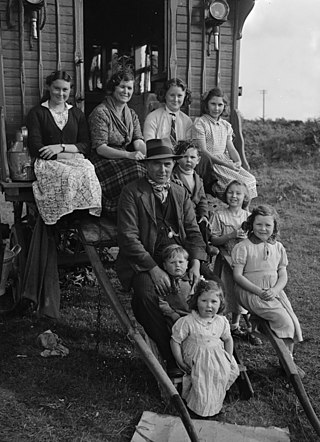Top Qs
Timeline
Chat
Perspective
Kale (Welsh Roma)
Romani subgroup in Wales From Wikipedia, the free encyclopedia
Remove ads
The Kale /kɑːˈleɪ/ (also Kalé, Kalá, Valshanange; Welsh: Roma yng Nghymru, Sipsiwn Cymreig, Cale) are a Romani subgroup predominantly found in northwestern Wales, specifically in the Welsh-speaking areas. Roma have been present in Wales since the 16th century.[2]
The Kale were traditionally renowned musicians, and are reported to have introduced the fiddle to Wales.[3][4] They were also known for their distinctive styles of clothing, dance, poetry and storytelling.[3][5][6]

The Kale are closely related to the Romanichal, Romanisael, Kaale and Scottish Lowland Roma.[7][8] They are considered part of the Gypsy (Romani), Roma and Traveller (GRT) community.[9] Romanichal are present in South Wales (in and around Cardiff, Swansea and Newport) and North East Wales (in and around Wrexham as well as in parts of Wales close to Liverpool and Chester). The Romani people can trace their origins to South Asia, likely in the regions of present-day Punjab, Rajasthan and Sindh.[10][11][12][13]
Remove ads
Language
The Kale spoke the traditional Welsh Romani language (Kalá) until at least the 1950s, when the language became a mixed language.[6][14] While the traditional language mostly consisted of words of Indo-Aryan origin, it also incorporated words derived from Persian, Arabic, Greek, Romanian and French, among others.[6]
Kalá is a variety of the Romani language closely related to Angloromani, Scottish Cant, Kàlo and Scandoromani. Originally the Kalá and Angloromani variants constituted a common Romani dialect.[15][8]
Remove ads
Culture

Kale traditionally participated in regional and national eisteddfodau. John Robert Lewis, the husband of Abram Wood's granddaughter, would win prizes for harping in 1842, 1848, and 1850.[16] Another descendant, John Roberts (1816–1894),[17] earned the sobriquet "Telynor Cymru", and taught his whole family various instruments. His illustrious career culminated in a performance before Queen Victoria at Palé Hall in Llandderfel near Bala on 24 August 1889, on the occasion of the Royal Visit to Wales. John Roberts played with his nine sons, all of them on the harp.[18] The Kale often adopted Welsh surnames.[6]
Traditionally, the Kale were nomadic, living in wagons and tents. Each tribe was headed by a sero rom.[6]
Many Kale claim to be descendants of Abram Wood, who settled in Wales in the early 18th century.[19]
Remove ads
See also
Notes
References
External links
Wikiwand - on
Seamless Wikipedia browsing. On steroids.
Remove ads

